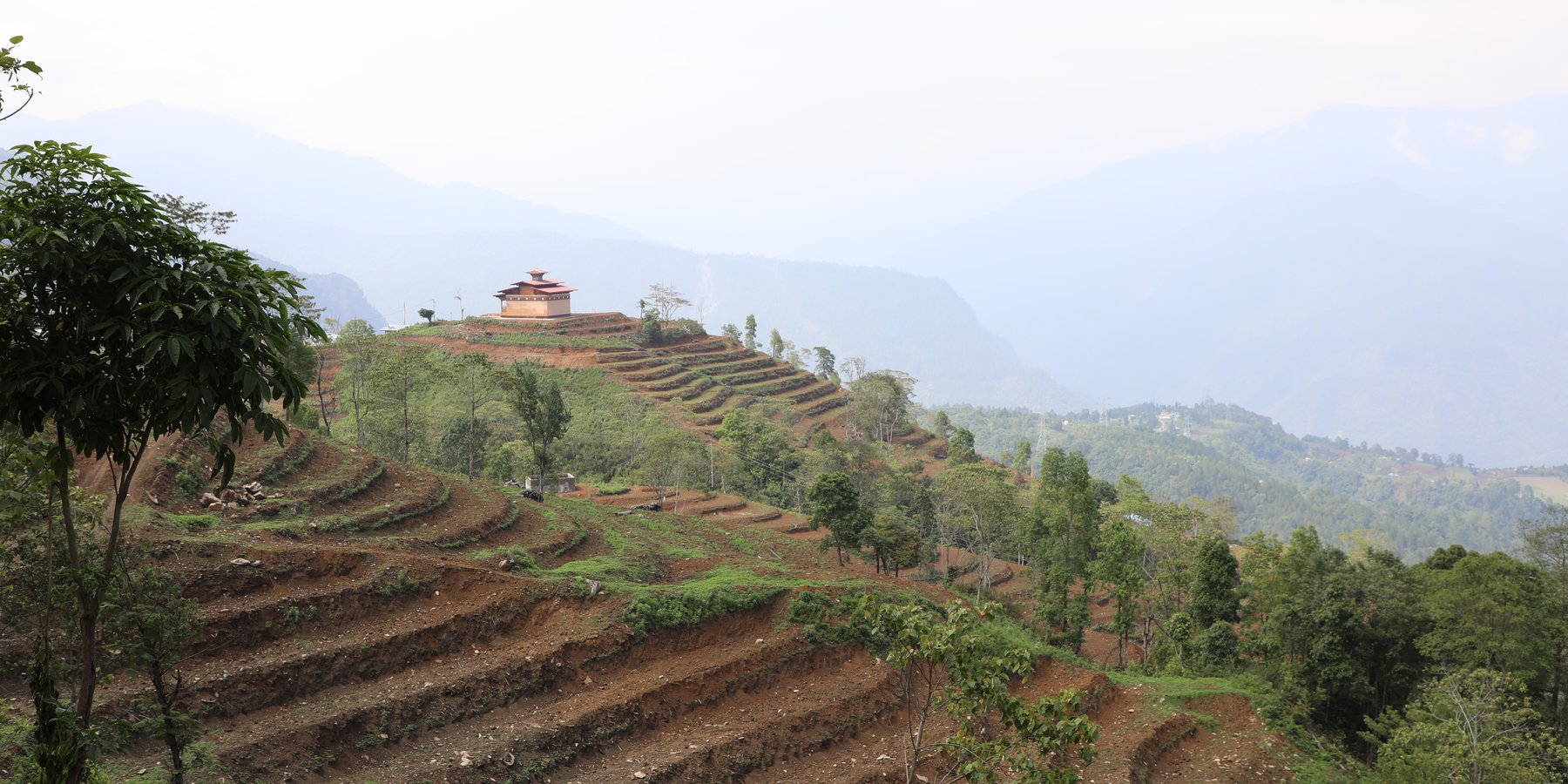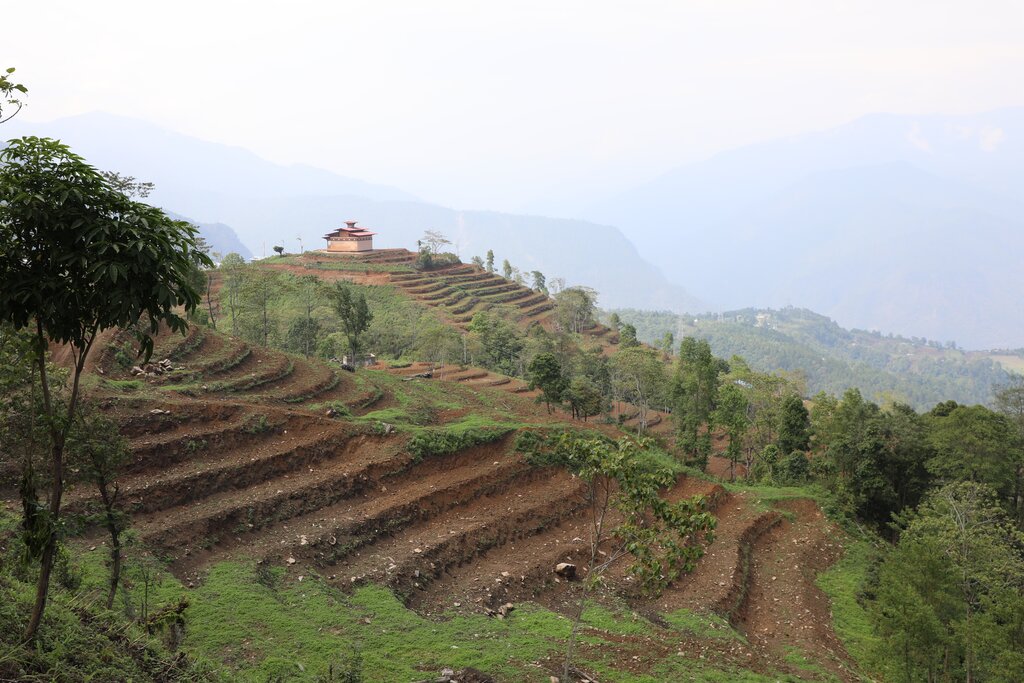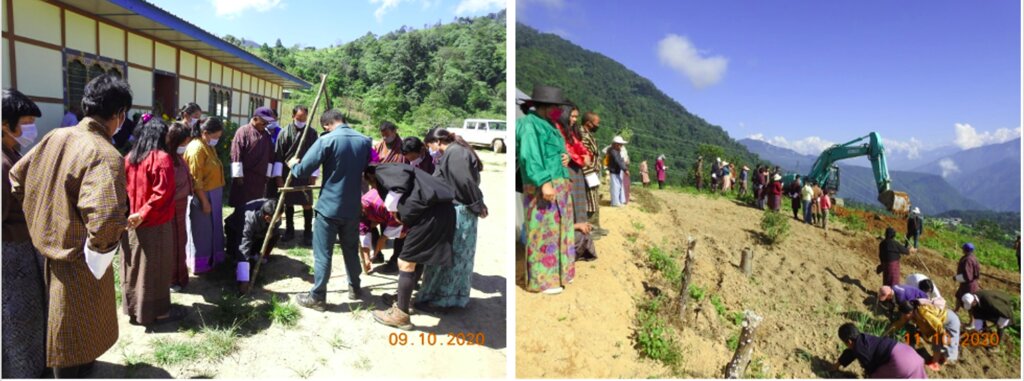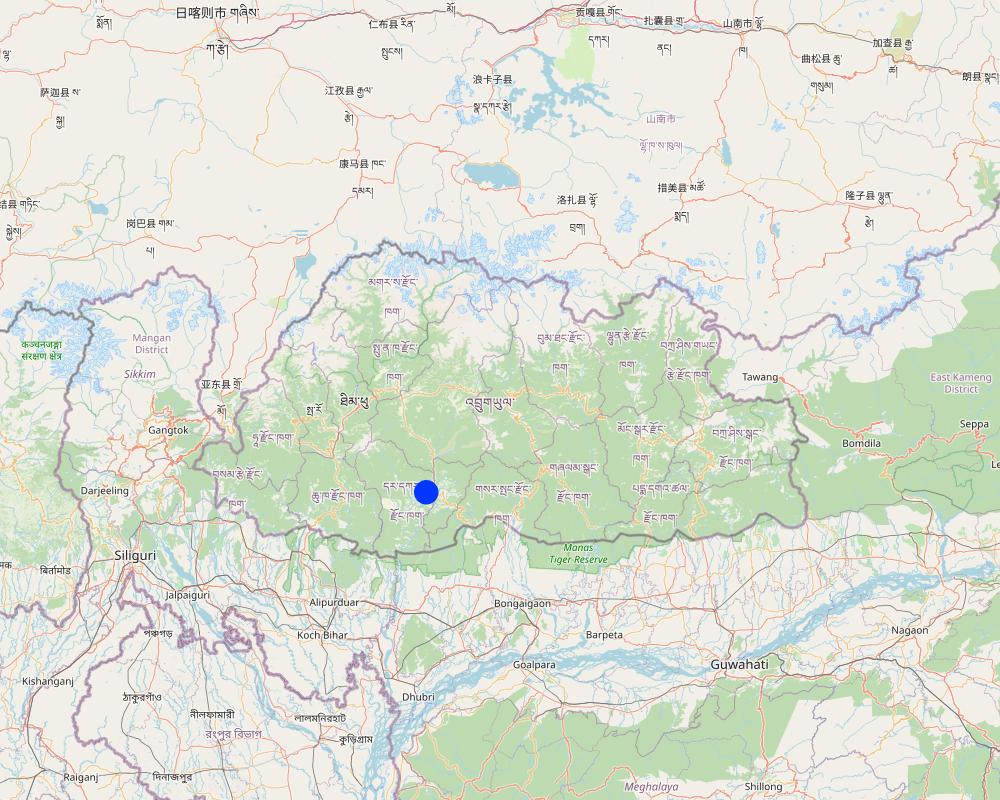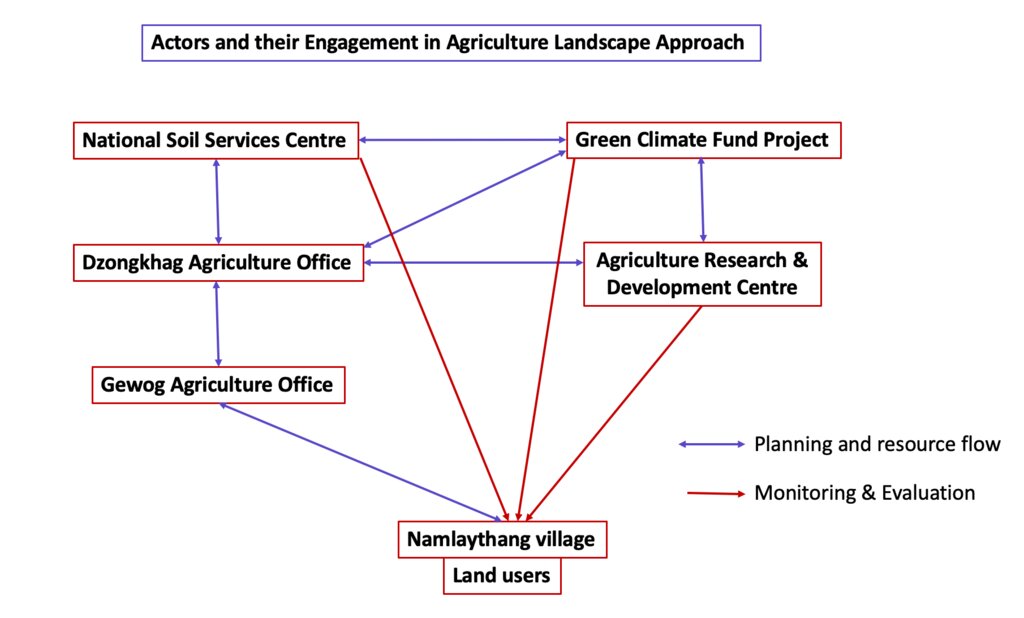Agricultural Landscape Approach for SLM Implementation [Bhoutan]
- Création :
- Mise à jour :
- Compilateur : Nima Dolma Tamang
- Rédacteur : Tashi Wangdi
- Examinateurs : William Critchley, Rima Mekdaschi Studer, Joana Eichenberger
Yuenten Sazhi Zinchong Gi Dhoen Lu Sanam Sazhing Ngoe Zin Bae Thang (ཡུན་བརྟན་ས་གཞི་འཛིན་སྐྱོང་གི་དོན་ལུ་སོ་ནམ་ས་ཞིང་ངོས་འཛིན་འབད་ཐངས་།)
approaches_6848 - Bhoutan
Voir les sections
Développer tout Réduire tout1. Informations générales
1.2 Coordonnées des personnes-ressources et des institutions impliquées dans l'évaluation et la documentation de l'Approche
Personne(s) ressource(s) clé(s)
exploitant des terres:
Dorji Damchoe
+97577463000
Namlaythang village, Tsangkha Gewog, Dagana Dzongkhag
Bhoutan
exploitant des terres:
Tsagay
77438522
Namlaythang village, Tsangkha Gewog, Dagana Dzongkhag
Bhoutan
exploitant des terres:
Dema Jigme
17405863
Namlaythang village, Tsangkha Gewog, Dagana Dzongkhag
Bhoutan
exploitant des terres:
Wangda Yeshi
17888916
Namlaythang village, Tsangkha Gewog, Dagana Dzongkhag
Bhoutan
exploitant des terres:
Norbu Nyagay
17504186
Namlaythang village, Tsangkha Gewog, Dagana Dzongkhag
Bhoutan
Nom du projet qui a facilité la documentation/ l'évaluation de l'Approche (si pertinent)
Strengthening national-level institutional and professional capacities of country Parties towards enhanced UNCCD monitoring and reporting – GEF 7 EA Umbrella II (GEF 7 UNCCD Enabling Activities_Umbrella II)Nom du ou des institutions qui ont facilité la documentation/ l'évaluation de l'Approche (si pertinent)
National Soil Services Centre, Department of Agriculture, Ministry of Agriculture & Livestock (NSSC) - Bhoutan1.3 Conditions relatives à l'utilisation par WOCAT des données documentées
Quand les données ont-elles été compilées (sur le terrain)?
11/07/2023
Le compilateur et la(les) personne(s) ressource(s) acceptent les conditions relatives à l'utilisation par WOCAT des données documentées:
Oui
2. Description de l'Approche de GDT
2.1 Courte description de l'Approche
The Agricultural Landscape Approach in Sustainable Land Management is a holistic and integrated strategy that focuses on managing agricultural landscapes in a sustainable manner. The approach was successfully initiated in Namlaythang village and transformed the whole agricultural landscape covering 107 acres (43 ha) while benefitting 55 resettled households.
2.2 Description détaillée de l'Approche
Description détaillée de l'Approche:
The Agriculture Landscape Approach in Sustainable Land Management (SLM) is a holistic and integrated strategy that focuses on managing agricultural landscapes in a sustainable manner. This approach recognizes the interrelation of various elements within a landscape, including soil, water, biodiversity, and human activities, ultimately aiming to optimize the benefits derived from these interactions while minimizing negative environmental impacts.
This approach was initiated in Namlaythang village under Tsangkha gewog (block), Dagana Dzongkhag (district). Namlaythang was chosen for this approach because it is a new settlement with 55 resettled households who were granted land ranging from 1.75 to 3 acres (0.7 to 1.2 hectares) per family by His Majesty the King as per the National Rehabilitation Program. Since the area was recently cleared and converted to settlement and farming, there was a huge risk of land degradation due to direct exposure to rain and unsustainable agriculture practices. Therefore, it was not only timely to implement SLM to prevent land degradation but also appropriate to have adopted the Agricultural Landscape Approach by engaging the whole community.
The main aim of adopting the agricultural landscape approach was to bring transformational change at a scale. Too often, we plan and implement SLM interventions supported by different projects in small, localized areas and in a scattered manner. This limits the ability to scale out success (both spatially and temporally) despite being positive initiatives. The approach was also intended to facilitate a multi-stakeholder platform by bringing relevant stakeholders together to discuss common objectives and draw synergies across different agencies.
The process started by discussing the idea with the Dzongkhag and gewog agriculture offices followed by sensitization of land users on the importance of SLM and its technologies. This was followed by Participatory SLM Action planning wherein detailed action plans were prepared based on landowners’ interest, feasibility of their land and the available technologies. The next mandatory activity carried out before implementation of SLM in the field was the conduct of field based hands-on training of the land users. The main SLM technologies planned and implemented included terracing, stone bunds, hedgerows, check dams/ gully plugs and plantations. In addition, climate resilient agriculture practices were also promoted such as greenhouses, low-cost water harvesting ponds, drip irrigation sets and fruit tree plantations.
In promoting this approach and other technologies, several stakeholders were involved including the Dzongkhag and gewog agriculture offices, National Soil Services Center (NSSC), Agriculture Research and Development Center, Bajo (ARDC-Bajo), the landowners and a Green Climate Fund (GCF) Project. The agricultural offices provided the overall coordination and the facilitation role in implementing the approach and its associated technologies. The NSSC provided sensitization and training on SLM technologies and also facilitated participatory SLM Action Planning with the landowners and other stakeholders. Similarly, the ARDC-Bajo arranged material inputs for climate resilient agriculture practices and provided technical assistance to the landowners and the gewog agriculture extension officer. The GCF Project provided financial support based on the action plan.
The implementation of SLM and climate resilient agriculture practices following agricultural landscape approach in Namlaythang have been a great success. The approach has brought a transformational change at the landscape level through various SLM interventions which collectively contributed towards reduction of soil erosion and nutrient loss, conservation of soil moisture and the improvement of overall soil health and food security. The land users also feel empowered through sensitization, capacity building and their engagement in the whole process. In brief, the land users expressed their satisfaction with the approach and the impacts it has created in the agricultural landscape which is the basis of their livelihoods.
A major weakness of the approach is that there is no institution/group/cooperative formed for efficient coordination among the land users and other stakeholders which questions its sustainability.
2.3 Photos de l'approche
2.4 Vidéos de l'Approche
Date:
11/07/2023
Nom du vidéaste:
Chimi Yangki
2.5 Pays/ région/ lieux où l'Approche a été appliquée
Pays:
Bhoutan
Région/ Etat/ Province:
Dagana Dzongkhag
Autres spécifications du lieu :
Goongpa-Soomchu Chiwog, Tsangkha Gewog
Map
×2.6 Dates de début et de fin de l'Approche
Indiquez l'année de démarrage:
2020
2.7 Type d'Approche
- fondé sur un projet/ programme
2.8 Principaux objectifs de l'Approche
To bring about transformational change through project intervention at the landscape level.
2.9 Conditions favorisant ou entravant la mise en œuvre de la(des) Technologie(s) appliquée(s) sous l'Approche
normes et valeurs sociales/ culturelles/ religieuses
- favorise
The strong community cooperation
disponibilité/ accès aux ressources et services financiers
- favorise
The SLM and climate resilient agriculture technologies were implemented with financial support provided by the government through a Green Climate Fund (GCF) project
cadre institutionnel
- favorise
The land users implement a labour-sharing system where all the land users come together to work in the field and go to the next after completion of that field. They take turns to work in the field of all the land users.
collaboration/ coordination des acteurs
- favorise
All the relevant stakeholders (Dzongkhag, Gewog, Research, NSSC, Land owners) came together in implementing SLM and climate resilient agriculture practices
cadre juridique (régime foncier, droits d'utilisation des terres et de l'eau)
- favorise
The land is granted by His Majesty the King to the landless families under Land Use Certificate (LUC), where the land users have the right to settle, cultivate and make a living from the land, but do not have right to sell their land.
cadre politique
- favorise
National Food and Nutrition Security 2022
Bhutan Water Policy 2007
gouvernance foncière (prise de décisions, mise en œuvre et application des décisions)
- favorise
The land users with land use right only. The land users can cultivate different crops on the land by implementing SLM technologies.
connaissances sur la GDT, accès aux supports techniques
- favorise
Technical support was provided by the Gewog Agriculture Extension Officer, Agriculture Research Development Centre (ARDC) and NSSC. Moreover, there is a willingness of the farmers to gain more knowledge and experience.
marchés (pour acheter les intrants, vendre les produits) et prix
- favorise
The village is well connected by the newly constructed farm road. All the farm produces can be marketed locally or can be taken to other markets
charge de travail, disponibilité de la main-d'œuvre
- entrave
Since most of the children were enrolled in schools, farm labour shortage is of major concern.
3. Participation et rôles des parties prenantes impliquées dans l'Approche
3.1 Parties prenantes impliquées dans l'Approche et rôles
- exploitants locaux des terres / communautés locales
Land owners
Attend sensitization and training program on SLM technologies and implement in the field.
- Spécialistes de la GDT/ conseillers agricoles
National Soil Services Center (NSSC)
NSSC provided training, sensitization and demonstration on SLM technologies to the land owners
- chercheurs
Agriculture Research and Development Centre (ARDC)
ARDC provided material inputs and technical assistance in implementing Climate Resilient Agriculture Practices in the field.
- gouvernement local
Dzongkhag and gewog agriculture offices
The Dzongkhag and gewog agriculture offices arranged financial and technical assistance in implementing SLM and Climate Resilient Agriculture Practices in the field while also coordinating and facilitating the whole implementation process.
- organisation internationale
United Nations Development Programme (UNDP)
Provided financial support through a Green Climate Fund (GCF) Project
3.2 Participation des exploitants locaux des terres/ communautés locales aux différentes phases de l'Approche
| Participation des exploitants locaux des terres/ communautés locales | Spécifiez qui était impliqué et décrivez les activités | |
|---|---|---|
| initiation/ motivation | interactive | The land owners actively participate in the initial discussion on the SLM implementation following landscape approach. The process was facilitaed by the local government officials. |
| planification | interactive | The land onwers and the local elected leaders were involved in the participatory SLM action planning that was facilitated jointly by the Dzongkhag and the NSSC. |
| mise en œuvre | auto-mobilisation | Land owners organized themselves into informal groups to implement SLM interventions with technical assistance from the Dzongkhag, gewog and ARDC. |
| suivi/ évaluation | interactive | Land owners were involved in the periodic monitoring and evaluation carried out jointly by the Dzongkhag, gewog, NSSC, ARDC and the GCF project. |
3.3 Diagramme/ organigramme (si disponible)
Description:
This Flow chart shows the actors and their involvement in implementing Agricultural Landscape Approach in Namlaythang. It clearly shows that for planning and resource mobilization, other actors including the National Soil Services Centre, Green Climate Fund Project and the Agriculture Research and Development Centre worked through the Dzongkhag and Gewog Agriculture Offices. But for monitoring and evaluation, those actors can come directly to the field and carry out monitoring and evaluation without necessarily engaging the Dzongkhag and Gewog Agriculture Offices. However, if there is a need, they can inform and invite Dzongkhag and Gewog Agriculture Officials.
Auteur:
Tashi Wangdi
3.4 Prises de décision pour la sélection de la Technologie/ des Technologies
Indiquez qui a décidé de la sélection de la Technologie/ des Technologies à mettre en œuvre:
- tous les acteurs concernés dans le cadre d'une approche participative
Expliquez:
Following the sensitization on SLM technologies, Participatory SLM Action Planning was carried out wherein the land owners, gewog agriculture extension and the SLM Specialists from NSSC jointly select and decide on SLM technologies to be implemented in the field.
- The decision was made based on the sensitization and the feasibility of the farming landscape.
4. Soutien technique, renforcement des capacités et gestion des connaissances
4.1 Renforcement des capacités/ formation
Une formation a-t-elle été dispensée aux exploitants des terres/ autres parties prenantes?
Oui
Spécifiez qui a été formé:
- exploitants des terres
Si pertinent, spécifiez le genre, l'âge, le statut, l'ethnie, etc.
Gender equity is generally maintained by inviting equal number of male and female participants and of different age groups.
Formats de la formation:
- zones de démonstration
Thèmes abordés:
SLM Technologies (Terracing, hedgerows, stone bunds, plantations and check dams)
Commentaires:
The training was field based and practical oriented.
4.2 Service de conseils
Les exploitants des terres ont-ils accès à un service de conseils?
Oui
Spécifiez si le service de conseils est fourni:
- dans les champs des exploitants?
Décrivez/ commentez:
Advisory services were provided by the agriculture advisers from the Dzongkhag and Gewog Agriculture offices.
4.3 Renforcement des institutions (développement organisationnel)
Des institutions ont elles été mises en place ou renforcées par le biais de l'Approche?
- oui, beaucoup
Spécifiez à quel(s) niveau(x), ces institutions ont été renforcées ou mises en place:
- local
- régional
- national
Décrivez l'institution, ses rôles et responsabilités, ses membres, etc.
There is no new institution established within the approach. However, various institutions were involved in promoting the technologies under the approach. At the local level, Dzongkhag and Gewog agriculture offices were involved in overall coordination and provided technical guidance. The Dzongkhag agriculture offices were also involved in sourcing funds for the implementation of the approach. Regional Agriculture Research and Development Center, Bajo (ARDC-Bajo) arranged material inputs for climate-resilient agriculture practices and provided technical assistance to the gewog agriculture extension officer and land owners. National Soil Service Center (NSSC) provided sensitization and training on SLM technologies and also facilitated participatory SLM Action Planning with the land owners and other stakeholders. The Green Climate Fund (GCF) Project was the main funding agency providing financial support based on the action plan.
Précisez le type de soutien:
- financier
- renforcement des capacités/ formation
- équipement
Donnez plus de détails:
The major financial support was provided by the GCF project and minor fund support was provided by the government for the implementation of the approach. Various stakeholders including NSSC, ARDC-Bajo, Dzongkhag and gewog offices were involved in the capacity building of the land owners. However, gewog offices were involved constantly due to the proximity and direct contact with the land owners. Equipment for the construction of greenhouses, low-cost water harvesting ponds, drip irrigation, terracing, stone bunds, hedgerows and check dams were provided during the implementation of technologies under the approach.
4.4 Suivi et évaluation
Le suivi et l'évaluation font ils partie de l'Approche? :
Oui
Commentaires:
The monitoring and evaluation are periodically done by the Dzongkhag Agriculture Office, NSSC and the Project Management Unit of the GCF Project.
Si oui, ce document est-il destiné à être utilisé pour le suivi et l'évaluation?
Oui
Commentaires:
The documentation is intended to be used for monitoring and evaluation and also for knowledge sharing.
4.5 Recherche
La recherche a-t-elle fait partie intégrante de l’Approche?
Non
5. Financement et soutien matériel externe
5.1 Budget annuel de la composante GDT de l'Approche
Si le budget annuel précis n'est pas connu, indiquez une fourchette:
- 10 000-100 000
Commentez (par ex. principales sources de financement/ principaux bailleurs de fonds):
The main funding source is GCF project
5.2 Soutiens financiers/ matériels fournis aux exploitants des terres
Les exploitants des terres ont-ils reçu un soutien financier/ matériel pour la mise en œuvre de la Technologie/ des Technologies?
Oui
Si oui, spécifiez le(s) type(s) de soutien, les conditions et les fournisseurs:
The implementation of all the SLM technologies was funded by the GCF project. Besides, land owners also received material supports such as greenhouses, low cost water harvesting ponds, drip irrigation sets, seeds and seedlings with financial support from the project and government.
5.3 Subventions pour des intrants spécifiques (incluant la main d'œuvre)
- intrants agricoles
| Spécifiez les intrants subventionnés | Dans quelle mesure | Spécifiez les subventions |
|---|---|---|
| semences | entièrement financé | Vegetable seeds |
- matériaux de construction
| Spécifiez les intrants subventionnés | Dans quelle mesure | Spécifiez les subventions |
|---|---|---|
| pierres | entièrement financé | For stone check dam construction in the gullies |
| bois | entièrement financé | For log check dam construction in the gullies |
- infrastructures
| Spécifiez les intrants subventionnés | Dans quelle mesure | Spécifiez les subventions |
|---|---|---|
| Greenhouse | entièrement financé | Prefabricated Greenhouse sets |
Si la main d'œuvre fournie par les exploitants des terres était un intrant substantiel, elle était:
- volontaire
Commentaires:
Land owners usually arrange their own family labour or through labour exchange to implement SLM technologies in the field.
5.4 Crédits
Des crédits ont-ils été alloués à travers l'Approche pour les activités de GDT?
Non
5.5 Autres incitations ou instruments
D'autres incitations ou instruments ont-ils été utilisés pour promouvoir la mise en œuvre des Technologies de GDT?
Oui
Si oui, spécifiez:
The SLM Technologies and Climate Resilient Agriculture practices were provided in line with the SLM Guidelines and Best Practices 2021 and the Cost Sharing Mechanisms of the Ministry of Agriculture and Livestock.
6. Analyses d'impact et conclusions
6.1 Impacts de l'Approche
Est-ce que l'Approche a autonomisé les exploitants locaux des terres, amélioré la participation des parties prenantes?
- Non
- Oui, un peu
- Oui, modérément
- Oui, beaucoup
The approach empowered local land users through capacity building and self-mobilization in implementing SLM technologies in the field.
Est-ce que l'Approche a aidé les exploitants des terres à mettre en œuvre et entretenir les Technologies de GDT?
- Non
- Oui, un peu
- Oui, modérément
- Oui, beaucoup
The landscape approach encouraged all the land owners to participate and implement SLM Technologies.
Est-ce que l'Approche a amélioré la coordination et la mise en œuvre de la GDT selon un bon rapport coût-efficacité?
- Non
- Oui, un peu
- Oui, modérément
- Oui, beaucoup
The landscape approach enabled stakeholders to converge and coordinate better planning and implementation by avoiding duplication and harnessing synergy and complimentary effects.
The landscape approach was used in accessing financial support from the GCF Project.
Est-ce que l'Approche a amélioré les connaissances et les capacités des exploitants des terres pour mettre en œuvre la GDT?
- Non
- Oui, un peu
- Oui, modérément
- Oui, beaucoup
The training and technical support were provided to the land users improving their knowledge and skills to implement SLM technologies.
Est-ce que l'Approche a construit/ renforcé les institutions, la collaboration entre parties prenantes?
- Non
- Oui, un peu
- Oui, modérément
- Oui, beaucoup
The landscape approach greatly enhanced collaboration between the existing stakeholders as it brought all the relevant stakeholders together to improve the land on which people depend for their livelihoods. For example, the gewog extension officers were trained by NSSC and ARDC-Bajo to disseminate technical information to the land users. However, there is no institution/group formed as part of the approach through which land users communicate within themselves or with other stakeholders to maintain or improve the technologies under the approach.
Est-ce que l'Approche a conduit à améliorer la sécurité alimentaire et/ou la nutrition?
- Non
- Oui, un peu
- Oui, modérément
- Oui, beaucoup
Through this approach different SLM and Climate Resilient Agriculture practices were implemented which ensures better soil health, better soil productivity and improved food security.
Est-ce que l'Approche a conduit à améliorer l'accès à l'eau et l'assainissement?
- Non
- Oui, un peu
- Oui, modérément
- Oui, beaucoup
Through this approach, certain supports were given to improve access and better utilization of water resource.
Est-ce que l'Approche a amélioré la capacité des exploitants des terres à s'adapter aux changements/ extrêmes climatiques et a atténué les catastrophes liées au climat?
- Non
- Oui, un peu
- Oui, modérément
- Oui, beaucoup
The landscape approach did improve the capacity of the land users through training and their active participation in the implementation of SLM technologies in the field.
Est-ce que l'Approche a conduit à des emplois, des opportunités de revenus?
- Non
- Oui, un peu
- Oui, modérément
- Oui, beaucoup
The landscape approach did contribute moderately to employment and income opportunities as some of the SLM technologies encouraged land owners to work their land and produce more for cash income.
6.2 Principale motivation des exploitants des terres pour mettre en œuvre la GDT
- augmenter la production
The land is the basis of food production. So any improvement in land will contribute towards better production.
- augmenter la rentabilité/ bénéfice, rapport coûts-bénéfices
The land is a main source of livelihood for the land users and a source of income. Therefore, taking care of the land to prevent erosion and ease farming is one of the main priorities.
- réduire la dégradation des terres
Reducing land degradation is the main motivation of the land users as their land which was under forest cover was recently cleared and allocated to the land users for agricultural use. Thus the risk of surface erosion and landslides is high as the land surface is exposed directly to sun and rain. Therefore, the implementation of SLM technologies such as terracing, hedgerows, stone bunds and check dams help reduce soil erosion and landslides.
- réduire les risques de catastrophe
Implementation of SLM technologies reduces the vulnerability of the land to disasters such as landslides and erosion.
- améliorer les connaissances et compétences en GDT
The land owners were sensitized, trained and actively involved in the implementation of SLM Technologies.
- améliorer l'esthétique
Physical land terracing improves aestheic value and look of the agricultural landscape.
6.3 Durabilité des activités de l'Approche
Les exploitants des terres peuvent-ils poursuivre ce qui a été mis en œuvre par le biais de l'Approche (sans soutien extérieur)?
- oui
Si oui, décrivez de quelle manière:
Based on the experience that land users have gained over the past 5 years, the land owners can sustain the technology implemented through this approach without external support as the maintenance cost is very minimal. The land owners feel that they can carry out maintenance on their own.
6.4 Points forts/ avantages de l'Approche
| Points forts/ avantages/ possibilités du point de vue de l'exploitant des terres |
|---|
| The community has not experienced any reported problems related to landslides, indicating the positive impact of terracing and check dams that have ensured the overall stability and sustainability of the area. |
| The land users can make a living from increased agricultural production and cash income. |
| Since the land was granted by His Majesty the King, the community receives so much of attention and technical support from different agencies. This has enabled the land users to avail much needed SLM interventions through the landscape approach. |
| Points forts/ avantages/ possibilités du point de vue du compilateur ou d'une autre personne ressource clé |
|---|
| The land users are exposed to new knowledge and skills to implement SLM technologies, which could serve as a model for further replication in other areas. |
| There is a transformational change at the landscape level, which otherwise becomes difficult if landscape approach was not adopted. |
6.5 Faiblesses/ inconvénients de l'Approche et moyens de les surmonter
| Faiblesses/ inconvénients/ risques du point de vue de l’exploitant des terres | Comment peuvent-ils être surmontés? |
|---|---|
| No institution/group/cooperative has been formed for efficient coordination among the land users. | By forming a permanent or formal group to continue the implementation and management of the SLM technologies. |
| Limited integration of livestock and forest related technologies due to limited fund. | Explore additional funding source from other sources such as Bhutan Trust Fund for Environmental Conservation (BTFEC) and UNDP Small Grant Project (SGP) to support implementation of livestock and forestry activities. |
| Faiblesses/ inconvénients/ risques du point de vue du compilateur ou d'une autre personne ressource clé | Comment peuvent-ils être surmontés? |
|---|---|
| No lead agency or personnel to initiate group formation. | The Gewog Agriculture Extension Officer could lead the group formation if they feel the need. |
| Lack of frequent monitoring of the implemented SLM technologies leading to reduced performance in terms of agriculture production and maintenance of the SLM technologies. | Ensure timely monotiring from the Gewog and Dzongkhag Agriculture offices |
7. Références et liens
7.1 Méthodes/ sources d'information
- visites de terrain, enquêtes sur le terrain
Five
- interviews/entretiens avec les exploitants des terres
Five
7.2 Références des publications disponibles
Titre, auteur, année, ISBN:
Sustainable Land Management (SLM) Guidelines and Best Practices 2021, The National Soil Services Center, Department of Agriculture, Ministry of Agricultue and Livestock
Disponible à partir d'où? Coût?
The National Soil Services Center, Semtokha, Thimphu, Bhutan
7.3 Liens vers les informations pertinentes disponibles en ligne
Titre/ description:
Zhesar namleythang
URL:
https://www.facebook.com/people/Zhesar-namleythang/100063962648613/?paipv=0&eav=AfZtqSeoJRJKQqV2pCQNI-Il9HsLY_XP-7nuLPGmeGHxTe7zq2FNEBbJReJwVuGjErk&_rdr
Liens et modules
Développer tout Réduire toutLiens
Aucun lien
Modules
Aucun module trouvé


